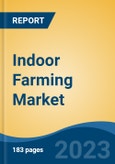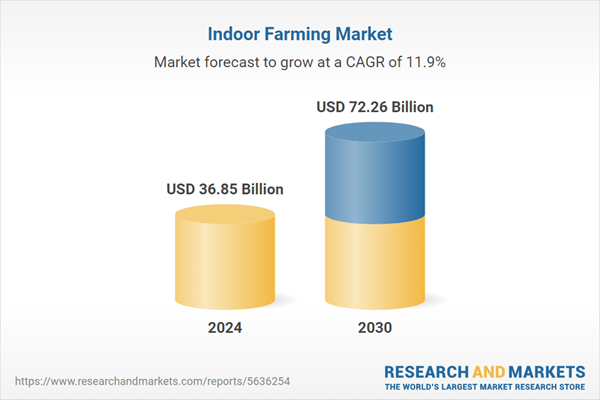Free Webex Call
Global Indoor Farming Market was valued at USD 36.85 Billion in 2024 and is expected to reach USD 72.26 Billion by 2030 with a CAGR of 11.88% during the forecast period. Indoor farming is an agricultural method that involves cultivating crops in controlled environments such as warehouses, greenhouses, or other indoor facilities. It utilizes artificial lighting, climate control, and advanced technologies like hydroponics, aeroponics, or aquaponics. Speak directly to the analyst to clarify any post sales queries you may have.
10% Free customizationThis report comes with 10% free customization, enabling you to add data that meets your specific business needs.
The primary objective is to achieve efficient and sustainable food production, particularly in urban areas where traditional farming methods may face challenges due to limited space, poor soil quality, or adverse weather conditions. Urban farming of this nature helps to reduce the carbon footprint associated with conventional agriculture by minimizing water, fertilizer, and pesticide usage, as well as transportation costs and food waste. These systems can vary in size, complexity, and crop variety, ranging from small-scale home gardening setups to large commercial operations. Commonly grown crops in indoor farming include leafy greens, herbs, microgreens, strawberries, tomatoes, cucumbers, and peppers.
Key Market Drivers
Rapid Urbanization & Limited Outdoor Agricultural Space
The dawn of rapid urbanization coupled with limited outdoor agricultural space has positioned indoor farming as a promising solution to address global food security concerns. As cities expand and develop, available land for traditional agriculture is exponentially decreasing. This is sharpened by increasing urban populations who demand fresh, local produce. Indoor farming, with its space-efficient and controlled environment agriculture techniques, is poised to meet this demand. It offers the ability to grow crops, irrespective of weather conditions, and without the requirement of vast farmland.Importantly, urban-based indoor farming reduces the 'food miles' associated with delivering produce from rural farms to urban consumers, enhancing freshness and reducing carbon emissions. Indoor farming techniques like hydroponics, aeroponics, and aquaponics are resource-efficient, using a fraction of the water compared to traditional farming. Furthermore, indoor farms can be stacked vertically, maximizing production per square foot - a major advantage in land-scarce urban areas.
The combination of these factors suggests a significant potential for indoor farming to not only sustain, but also thrive in the face of rapid urbanization and limited outdoor agricultural space. The expected result is a surge in demand for indoor farming practices globally, a trend set to redefine the future of agriculture. According to The World Bank Group, the amount of arable land per capita has decreased from 0.197 hectares in 2013 to 0.192 hectares in 2016. The growing scarcity of arable land, driven by land degradation, has prompted farmers to seek new solutions for producing fresh food.
Key Market Challenges
High Initial Investment
High initial investment in indoor farming is a significant factor expected to reduce its global demand. Indoor farming, though a promising solution to urban space constraints and climate change issues, requires substantial upfront capital. Costs associated with advanced farming technologies, such as hydroponics, aeroponics, or aquaponics, and energy-efficient lighting systems, can be prohibitively high. Moreover, the necessary infrastructure, including climate-controlled environments and automated systems for nutrient delivery, adds to the initial expense. These high start-up costs serve as a deterrent for potential entrants, particularly small-scale farmers, who may lack the requisite capital.Additionally, the return on investment (ROI) in indoor farming is not immediate, with profitability often only achievable in the long term. This aspect could further discourage entrants, particularly in developing economies. Lastly, the ongoing operational costs, including those for energy, labor, and maintenance, further increase the financial burden, potentially outweighing the benefits of indoor farming. In the face of these factors, the high initial investment required for indoor farming is expected to depress its global demand.
Key Market Trends
Rise in Control Over Crop Cultivation & Management
The rise in control over crop cultivation and management through the advancement of indoor farming is expected to significantly increase its global demand. Indoor farming, a method of cultivating crops within indoor systems, offers precise management of environmental factors such as light, humidity, temperature, and nutrient control. This level of precision ensures the production of high-quality crops year-round, regardless of external weather conditions.Moreover, indoor farming allows for the cultivation of a greater diversity of crops than traditional farming methods, including crops that are typically not suitable for certain climates or regions. As global food demand continues to surge, indoor farming's ability to grow more with less will be a critical factor in meeting this demand sustainably. By optimizing resource usage, such as water, energy, and land, indoor farming demonstrates its potential to address the challenges of food security and environmental sustainability. Furthermore, indoor farming mitigates the risks of crop failure due to pests, diseases, or adverse weather, providing a more reliable and consistent food source for communities.
The reliability, increased productivity, and efficiency of indoor farming are expected to attract more investors and stakeholders to this innovative approach. As awareness grows about the benefits of indoor farming, including reduced environmental impact and shorter supply chains, the global demand for indoor farming is projected to continue its upward trajectory.
Key Market Players
- LumiGrow Inc.
- Signify Holding BV
- Argus Control Systems Ltd.
- Netafim Ltd
- Logiqs BV
- Vertical Farm Systems
- General Hydroponics, Inc.
- Heliospectra AB
- Bright Farms Inc.
- Bowery Farming Inc.
Report Scope:
In this report, the Global Indoor Farming Market has been segmented into the following categories, in addition to the industry trends which have also been detailed below:Indoor Farming Market, By Farming Technique:
- Hydroponics
- Aeroponics
- Aquaponics
- Soil-Based
- Hybrid
Indoor Farming Market, By Facility Type:
- Greenhouse
- Indoor Vertical Farm
- Container Farm
- Others
Indoor Farming Market, By Component:
- Irrigation Component
- Lighting
- Sensor
- Climate Control
- Others
Indoor Farming Market, By Crop Type:
- Fruits & Vegetables
- Herbs & Greens
- Flowers & Ornamentals
- Others
Indoor Farming Market, By Region:
- North America
- United States
- Canada
- Mexico
- Europe
- France
- United Kingdom
- Italy
- Germany
- Spain
- Asia-Pacific
- China
- India
- Japan
- Australia
- South Korea
- South America
- Brazil
- Argentina
- Colombia
- Middle East & Africa
- South Africa
- Saudi Arabia
- UAE
Competitive Landscape
Company Profiles: Detailed analysis of the major companies present in the Global Indoor Farming Market.Available Customizations:
With the given market data, the publisher offers customizations according to a company's specific needs. The following customization options are available for the report.Company Information
- Detailed analysis and profiling of additional market players (up to five).
This product will be delivered within 1-3 business days.
Table of Contents
1. Product Overview
2. Research Methodology
3. Executive Summary
5. Global Indoor Farming Market Outlook
6. North America Indoor Farming Market Outlook
7. Europe Indoor Farming Market Outlook
8. Asia-Pacific Indoor Farming Market Outlook
9. South America Indoor Farming Market Outlook
10. Middle East and Africa Indoor Farming Market Outlook
11. Market Dynamics
12. Market Trends & Developments
14. Porter’s Five Forces Analysis
15. Competitive Landscape
Companies Mentioned
- LumiGrow Inc.
- Signify Holding BV
- Argus Control Systems Ltd.
- Netafim Ltd
- Logiqs BV
- Vertical Farm Systems
- General Hydroponics, Inc.
- Heliospectra AB
- Bright Farms Inc.
- Bowery Farming Inc.
Table Information
| Report Attribute | Details |
|---|---|
| No. of Pages | 185 |
| Published | March 2025 |
| Forecast Period | 2024 - 2030 |
| Estimated Market Value ( USD | $ 36.85 Billion |
| Forecasted Market Value ( USD | $ 72.26 Billion |
| Compound Annual Growth Rate | 11.8% |
| Regions Covered | Global |
| No. of Companies Mentioned | 10 |









